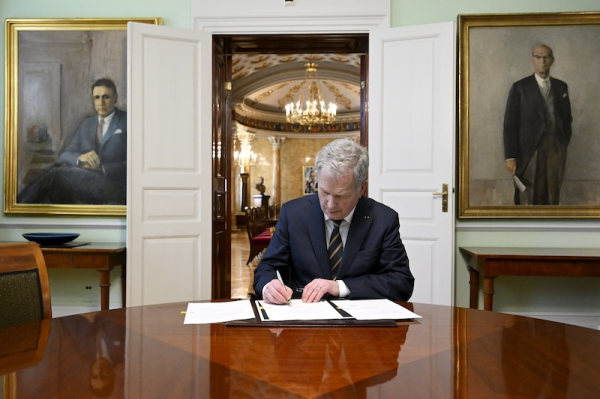Niinistö’s memoir reveals Putin’s pressure, Erdogan’s demands and Finland’s path to NATO

Finland’s former President Sauli Niinistö signing Finland’s national Nato legislation in Helsinki, Finland on March 23, 2022. Niinistö describes in his recent book: Trump and Putin seemed like strangers to each other. Photo: Markku Ulander / Lehtikuva
- Next Article Valtonen fined in Georgia after protest support video
President Sauli Niinistö describes a decade of Finnish foreign policy shaped by Russian pressure, NATO negotiations, and power struggles behind the scenes. His memoir, Kaikki tiet turvaan – Sinnikkään Suomen suunta (All roads to security – The course of a persistent Finland), offers an inside account of Finland’s transformation from neutrality to military alliance.
In meetings with Vladimir Putin, Niinistö faced thinly veiled threats disguised as historical references and humour. At a 2012 meeting in Karelia, Putin asked why Finland wanted to join NATO, remarking that “you won’t get Karelia back”. Niinistö responded that Finland was not applying for membership but deepening cooperation for its own security.
“Well, every independent country maximises its security,” he told Putin.
In 2017, as Russian naval exercises took place in the Baltic Sea, Putin said they were “not aimed at anyone”. Niinistö replied that Finland, too, would join Sweden’s upcoming Aurora drill, “also not aimed at anyone”.
During a 2018 meeting in Sochi, Putin pulled Niinistö aside and introduced members of the Russian Security Council. Foreign Minister Sergei Lavrov then presented a list of grievances, including NATO expansion and missile shields. Niinistö noted the performance was likely aimed at showing hardliners in Moscow that Putin was applying pressure on Finland.
Putin, according to Niinistö, respected strength. The Russian president also gifted him items rich in symbolism, including a 70th birthday present of Marshal Mannerheim’s letters and a medal once awarded to a senator who had opposed Russian oppression during the era of tsarist rule.
On the phone with Putin in early 2022, days before Russia’s full invasion of Ukraine, Niinistö informed him of Finland’s decision to apply for NATO membership. Putin, though calm, said it was a mistake and hinted that the US would dominate Finland’s military. “I will still be the one appointing the generals here.” Niinistö responded. Putin laughed.
US President Joe Biden had earlier suggested to Niinistö that Finland’s potential NATO membership might serve as a warning to Russia. Niinistö opted against making explicit threats, instead delivering a “sufficient warning” that Putin reportedly understood.
The NATO process exposed diplomatic fault lines. In May 2022, Turkey reversed its earlier support and questioned Finland and Sweden’s applications. In Madrid, Niinistö confronted Recep Tayyip Erdoğan, rejecting accusations of harbouring terrorists. When Erdoğan’s tone became lecturing, Niinistö replied, “We are not schoolchildren, drop that attitude.”
After prolonged negotiation, a trilateral memorandum was agreed. NATO Secretary General Jens Stoltenberg summarised the talks: “I was the good cop, you were the bad cop.”
Finland also encountered friction with Hungary. Prime Minister Viktor Orbán told Niinistö bluntly that Finland had made the wrong choice. When asked if Hungary’s own NATO accession was different, Orbán replied, “We are not a border state.”
By early 2023, Erdoğan agreed to separate Finland’s application from Sweden’s. Niinistö ensured the optics did not show him pleading for special treatment. On 17 March, Erdoğan signed the ratification documents.
Finland’s flag was raised at NATO headquarters on 4 April 2023.
The book also recounts moments of suspicion toward Sanna Marin’s government. Niinistö writes that the Prime Minister’s Office considered legal changes that would sideline the president from NATO decision-making. The idea was stopped by Niinistö’s staff. He writes, “My cabinet managed to shoot down these foolish ideas.”
Another episode involved a proposed joint call between Biden, Niinistö, and Sweden’s Prime Minister Magdalena Andersson. The Finnish side was surprised when the US queried whether Niinistö was available, having been informed that Marin might attend instead. Niinistö suspected the Swedish Social Democrats attempted to block his participation.
Despite political tension, Niinistö commended Marin for her handling of a joint US-Finland icebreaker deal discussed with Donald Trump in 2019. The deal, finalised in 2025, involves 11 vessels, with four to be built in Finland and seven in the US.
In Helsinki in 2018, Niinistö observed Trump and Putin meeting privately. He felt the two appeared cautious, perhaps unfamiliar with each other. “I would say they didn’t seem to have a very close connection, unless they were good actors.”
Trump frequently asked Niinistö why Finland was not in NATO and about his relationship with Putin.
The book also documents an earlier crisis in 2015, when over 1,800 asylum seekers crossed from Russia into Finland. Niinistö suspected the surge was retaliation for blocking entry to a Russian official subject to EU sanctions. He considered it a Russian signal cloaked in plausible deniability.
“People fear missiles, I fear they will send migrants,” he wrote in his diary.
Niinistö describes Putin as disciplined and ideological, shaped by KGB loyalty. When unhappy, his speech grew tense and rapid. Niinistö viewed Putin’s references to 19th-century Finland under Russian rule as deliberate pressure.
In contrast, Trump was direct, moving quickly from one topic to another. He often focused on leaders’ personalities rather than policy.
In private talks, Biden urged Niinistö to use NATO membership as leverage with Russia. Niinistö declined to make threats but acknowledged that the message was understood in Moscow.
The book concludes with reflections on Finnish defence. Niinistö maintains that despite neutrality, Finland consistently improved its capabilities, securing both hardware and strategic partnerships with the United States and Sweden.
His record, he argues, was not about shifting overnight but following a path where “minimisation of insecurity” became “maximisation of security”.
*quoted material from the book (Sauli Niinistö: Kaikki tiet turvaan – Sinnikkään Suomen suunta. WSOY) has been translated from Finnish into English.
HT
- Next Article Valtonen fined in Georgia after protest support video
Source: www.helsinkitimes.fi
